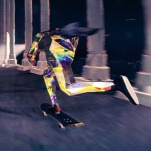That’s because Secret Of Kells isn’t about familiar Western fairy tales, but about exploring a part of Irish history that’s lost in the past, examining it with style and artifice rather than literal events. The film loosely illustrates the creation—and more significantly, the symbolic importance—of the Book Of Kells, a lavishly illuminated set of the Biblical gospels created around 800 A.D., and considered Ireland’s greatest artistic treasure. Directors Tomm Moore and Nora Twomey took visual inspiration from fascist posters, medieval illustrations, traditional Celtic art, Irish history and natural features, Bill Watterson, Ralph Steadman, Gustav Klimt, and gothic cathedral architecture, among many other things. They merged all these elements into a staggeringly rich visual wonderland, a world where a young monk named Brendan wanders and naturally finds inspiration for his work. Along the way, he meets a mysterious, shape-changing forest spirit named Aisling, who takes a liking to him. The Vikings are coming, sacking and burning monasteries in their wake, and Brendan’s grim uncle (voiced by Brendan Gleeson) is obsessed with protecting the monastery of Kells with a huge wall, but Brendan finds other obsessions in art and creation.
This all may sound a bit recondite and scholarly, but Moore and Twomey focus on the intensity of the emotions and the lushness of the world that calls Brendan away from his cloister. Visually, Secret Of Kells is a breathtaking movie, one where every frame seems to have dozens of dazzling layers. Tonally, it operates in a hushed, intense space, as though its breath has already been taken. The story is sometimes a little confusing, all the more so because it edges up to the shapes of those familiar Western fairy tales, then turns away at unexpected times, but a project this dense and passionately executed is worth the extracurricular work it takes to fully appreciate what the filmmakers are communicating. Alternately, instead of working to understand it, viewers can let the spectacular art wash over them, and accept it all as the dream-vision it is.
Key features: A quiet, info-dense commentary with the directors and art director, a 30-minute Moore presentation about the film’s visual inspirations, video of voice-actor tapings, pencil-to-final animation comparisons, and the brief animated Aisling clip from the Oscars. Best of all, an extended promotional trailer from an early version of the film called Rebel, showcasing a very different style and concept art.









































